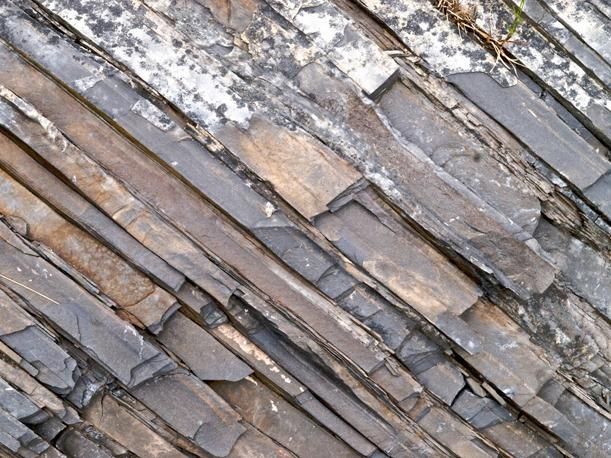Is Shale the Answer to America’s Nuclear Waste Woes?
With the plans for a Yucca Mountain waste repository scrapped, scientists suggest that clay-rich rocks could permanently house spent nuclear fuel
/https://tf-cmsv2-smithsonianmag-media.s3.amazonaws.com/filer/Surprising-Science-Shale-Nuclear-waste.jpg)
When plans were scrapped in 2009 for the Yucca Mountain nuclear waste repository, some worried that expansion of American nuclear power might dissolve along with it. Without a safe, permanent site to store the country’s 70,000 metric tons of nuclear waste–currently stored in temporary pools and dry casks at 75 sites around the country–it seemed that a robust expansion of nuclear power might have to be put on the back burner.
But a viable option might be on the horizon; in an article (pdf) published this week in Eos, the newspaper of the American Geophysical Union (AGU), U.S. Geological Survey hydrologist Christopher Neuzil suggests that shale–a mineral rock found in abundance in the United States–could be the key to a future of safe disposal for nuclear waste.
Shale and other argillaceous formations (any clay-rich media such as mudrocks) possess certain unique qualities which would make them prime candidates for the disposal of nuclear waste, Neuzil argues. Argillaceous formations have extremely low permeability, meaning that risk for toxic runoff from waste storage would be greatly reduced. Nuclear runoff is one of the greatest concerns for waste storage, which comes from waste dissolving in groundwater flowing through the storage area. Because water flows through shale at an extremely slow rate, Neuzil says that the material would act as a distinct barrier between nuclear waste and potential runoff. In fact, shale can act like a sponge, absorbing water without releasing any; this would allow nuclear waste to be stored safely, keeping the waste materials inside the formations.
Moreover, Neuzil cites the natural abundance of shale in the United States as a clear advantage. “The United States is in an enviable position with respect to the scale and sheer diversity in age, history, composition, and thickness of argillaceous formations within its borders,” Neuzil writes. “Geologically and geographically, potential choices for a repository are many.” Moreover, the locations of these formations constitute another benefit to waste storage; because the formations are often found in relatively old and geological stable areas, the risk for tectonic disturbance would be greatly reduced.
The low permeability of shale is something that Americans are starting to be familiar with–its what allows shale gas and oil, which forms when organic components within the rocks break down, to collect without escaping. In fact, fracking to extract shale gas is conducted to overcome shale’s impermeable nature. But rather than seeking to extract what may be inside the shale to produce energy, scientists like Neuzil see shale as a medium to house the byproducts of energy that has already been produced. And with nuclear energy responsible for nearly 20 percent of the nation’s energy production, our need to permanently dispose spent nuclear fuel grows every year.

The United States has only recently begun researching the potential for shale disposal, but Neuzil cites multiple studies which have been conducted–or are underway–in Europe and beyond, from the United Kingdom to Japan. France, Belgium and Switzerland have moved beyond the research process, and are currently devising plans to implement shale-storage of their nuclear waste (pdf). Though there is concern that emplacement would potentially disrupt the integrity of shale as a barrier to waste, studies in Europe suggest that the formations, even with cavities made for waste storage, maintain their ability to keep groundwater from carrying contaminates any measurable distance.
Shale is not without its caveats, however. Neuzil notes that the research surrounding shale’s potential for nuclear storage must be mostly extrapolated from other minerals, as shale’s low-rate of water flow also makes studying the phenomenon difficult. Instead of studying shale’s permeability in the long term, scientists use rocks with faster flow-rates, which are quicker and easier to study in the short term, and apply the properties to shale. This could pose threats to the long-term success of shale storage, as no data exists on its true ability to weather long-term storage situations.
So how do you actually get spent nuclear fuel into these clayey rocks? Neuzil suggests that the waste would be placed mostly in solid form. “Some waste may be vitrified, or mixed with molten glass that then solidifies. This may make it more difficult for the waste to contaminate any groundwater that contacts it,” he explained in an interview, adding that any waste would also be placed in canisters (stainless steel or copper) to further impede contamination of the ambient environment.
In April of this year, the Department of Energy announced plans to launch a new research and development project led by the Electric Power Research Institute (EPRI), a 15.8 million dollar investment that will center around design and implementation of dry cask storage for nuclear waste. The initative mentions nothing about expanding research to other options–geological or otherwise–though a spokesperson for the Department of Energy notes that they are currently “analyzing the capabilities of various geologic media, including clay, salt, crystalline rock and shale, for repository disposal in the United States,” as well as taking advantage of existing research conducted by other countries.